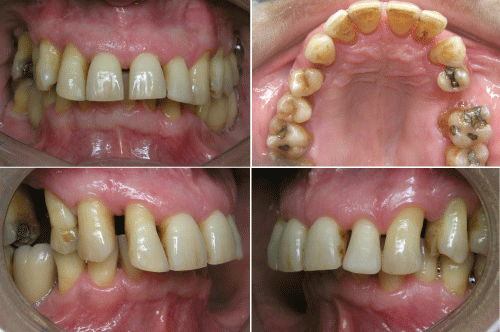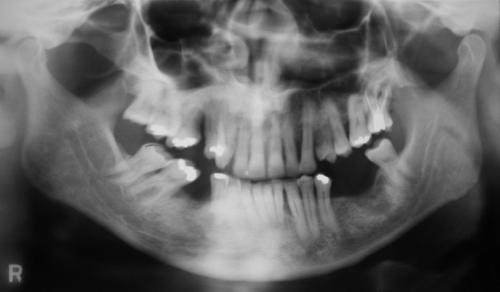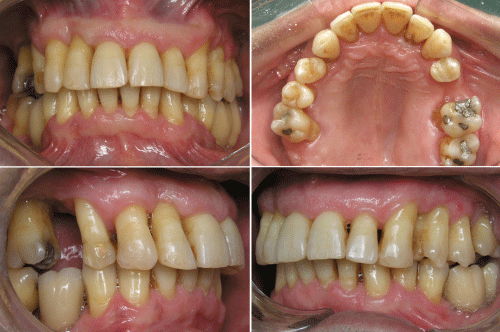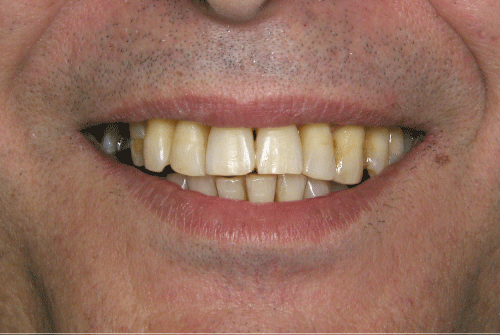
Case Report
J Dent App. 2014;1(2): 29-32.
Simultaneous Intrusion and Retraction of Migrated Periodontal Upper Incisors with Mini-Implants: A Case Report
Andre Wilson Machado1*, Renato Parsekian Martins2 and Emanuel Braga3
1Associate Professor, Department of Orthodontics, Federal University of Bahia, Salvador, Brazi
2Private practice and part-time adjunct faculty of the orthodontics graduate pro- gram, UNESP, São Paulo State University, Araraquara School of Dentistry, Araraquara, São Paulo, Brazil
3Associate Professor, Department of Orthodontics, Federal University of Bahia, Salvador, Brazil
*Corresponding author: Andre Wilson Machado, Av. Araújo Pinho, 62, 7° andar, Faculdade de Odontologia da Universidade Federal da Bahia, Salvador/BA, Brazil, Cep: 40.110-150
Received: June 23, 2014; Accepted: July 30, 2014; Published: Aug 02, 2014
Abstract
With the increased number of adult patients seeking treatment, orthodontists routinely encounter patients with advanced periodontitis. These situations are a challenge to the clinician since it is difficult to establish anchorage due to the reduced bone support. Thus, the use of skeletal anchorage for these clinical conditions has proved to be an excellent alternative. This case report demonstrates the use of mini-implant anchorage for 'en masse' simultaneous intrusion and retraction of maxillary anterior teeth in a 55-year-old male patient with a Class II deep bite malocclusion with advanced periodontitis. Acceptable occlusion and esthetic results were achieved demonstrating that mini-implants are useful in enhancing anchorage in patients with bone loss associated with severe periodontal disease.
Keywords: Orthodontics; Tooth intrusion; Bone anchor; Loss of periodontal insertion
Introduction
A common sequel of periodontal disease is the loss of bone support and, sometimes, the loss of posterior teeth. This condition, in the long term, will increase masticatories load on the anterior teeth leading to migration, elongation, spacing and protrusion of the incisors [1]. The literature describes several techniques for the solution of these problems such as the intrusion of anterior teeth and space closure [1-7].
In patients with active periodontal disease, orthodontic treatment is contraindicated because it may accelerate tissue breakdown [8]. However, it is clearly indicated in cases where the disease is controlled, despite the presence of periodontal sequelae, such as bone loss and gingival recession [9,10]. It is also believed that with the orthodontic treatment the patient may not experience additional loss of bone support [9,10]. Moreover, the loss of alveolar bone results in a shifting of the tooth's center of resistance apically, and the forces acting on the teeth will commonly cause tipping [11]. Therefore, orthodontic treatment should use light forces with appropriate mechanical control [2-5,12].
Another important aspect is that in those periodontal patients, planning should take into account that posterior teeth may not be used as anchorage units [2,12]. In such cases, skeletal anchorage comes as an excellent alternative since it provides adequate force control, reduces treatment time and does not require patient cooperation [4,13-15]. Furthermore, this approach has proved to be more effective than other traditional alternatives in some orthodontic movements such as incisor intrusion [16,17].
In order to obtain stationary near-to-absolute anchorage, zygoma ligatures [1], dental implants [18], miniplates [4] and mini-implants [2,5,15] have been extensively used. Of those alternatives, the latter are an excellent alternative to enhance orthodontic mechanics with some advantages: easy insertion and removal, low cost, immediate loading and simpler placement surgery at numerous anatomic locations [13- 15]. This approach has been widely described and studied but there have been few case reports on the correction of migrated and spaced incisors in patients with severe adult periodontitis [2,5]. Moreover, their use to achieve a genuine segmented simultaneous intrusion and retraction of incisors in a periodontal patient has not been addressed in the literature. This technique uses segmented arches to intrude and retract the upper incisors and similarly to other orthodontic mechanics, an adequate posterior anchorage control is needed [19].
The goal of this case report is to draw the attention of orthodontists to the possibility of adapting the segmented simultaneous intrusion and retraction of incisors mechanics in periodontal patients with mini-implant anchorage.
Case Report
Diagnosis
A 55-year old male patient had a chief complaint of spacing and protusion of the upper incisors. He had a history of severe periodontal disease and was treated over an eleven-month period with deep scaling and root planning, followed by regular periodontal maintenance. Bone grafting in the right upper premolar region was tried twice with no success, and even though the patient had widespread bone loss, oral hygiene was adequate and there was no gingival bleeding on probing. No signs of temporomandibular joint disorder were noted and there was no underlying medical condition.
The patient exhibited a symmetric face within normal standards, but a close-up assessment, however, revealed an unpleasant smile with protrusive, spaced and elongated upper incisors and root exposure (Figure 1).
Figure 1: Initial facial aspect of the patient.
He had a Class II malocclusion, division 1, with increased overjet (7mm) and overbite (6mm), absence of the upper right second bicuspid and some lower posterior teeth. Due to the extrusion of anterior teeth there were two occlusal planes in the upper arch (Figure 2 and 3).
Figure 2: Initial intraoral aspect of the patient.
Figure 3: Initial panoramic radiograph of the patient showing extensive bone loss.
Treatment objectives
The treatment objectives included [1] intrusion and retraction of the upper incisors with mini-implants as anchorage, [2] achieving adequate overbite and overjet for a satisfactory smile, [3] maintaining all existing teeth, [4] preventing further alveolar bone loss and [5] achieving acceptable functional occlusion.
Treatment progress
Simultaneous incisor intrusion and space closure was accomplished for the correction of both overjet and overbite. Standard 0.022" brackets were bonded to the upper anterior teeth (cuspid to cuspid) and a passive 0.021 x 0.025" sectional stainless steel archwire with crimpable hooks on the distal of the lateral incisors.
Two mini-implants (Sin, São Paulo, Brazil) were placed between the roots of the canines and first upper premolars and immediate light forces (80g) were applied with chain elastics, thereby producing vertical and horizontal force components to achieve the simultaneous 'en masse' intrusion and retraction of anterior teeth (Figure 4).
Figure 4: Simultaneous intrusion and retraction mechanics.
After the overjet and overbite were corrected and leveling of the upper occlusal plane was achieved, light chain elastics were used to close the remaining spaces (Figure 5). After this phase, the fixed appliance was removed, and retention began with a removable maxillary Essix® retainer.
Figure 5: Elastic chain to close remaining spaces.
An important aspect is that during treatment the periodontist carried out periodontal maintenance at three-month intervals.
Treatment results
Total treatment took 13 months and finals results show the anterior teeth intruded and the interdental spaces closed effectively, which shortened clinical crown length. No progressive gingival recession and pocket depths were detected after orthodontic treatment showing that the periodontal condition had improved. The incisal relationship was normalized, with proper overbite and overjet, (3mm and 2mm, respectively), and posterior occlusion was preserved as a result of the active treatment (Figure 6). The results were maintained with a removable wraparound retainer and no bonded retainer was used due to a relapsed poor oral hygiene.
Figure 6: Final intraoral aspect of patient.
Post treatment photo shows a more pleasant smile, despite certain esthetic peculiarities related to periodontal sequelae (Figure 7). Due to the esthetics improvement, the patient reported a higher level of self-confidence and was generally happier.
Figure 7: Close-up smile of patient after treatment.
Discussion
In the case presented, incisal relationship was normalized with proper overbite and overjet, accomplished through a controlled genuine intrusion and retraction. In order to achieve this result, the line of action of the force should be as close as possible to the center of resistance of the six anterior teeth, which is approximately distal to the upper lateral and 7mm apically [20]. To achieve this 'en masse' movement an adaptation was made to a technique already described which uses posterior teeth for anchorage [19]. Other authors manipulating this line of force have managed to produce different kinds of movements in similar cases, such as lingually tipping the incisors [1,2,5]. Assessing clinical results, it becomes evident that the axial inclination of the anterior teeth was maintained and the overbite reduced, demonstrating the effectiveness of the mechanics used and the genuine intrusion achieved. Therefore, satisfactory results were achieved, but due to aesthetic and functional limitations imposed by periodontal sequelae, results are far from the ideal pursued by conventional orthodontics.
The maintenance of the axial inclination of the incisors during intrusion is a difficult task in periodontal compromised patients. The loss of bone support causes the tooth's center of resistance to migrate apically, thereby increasing the tendency of the teeth to tilt towards the application of an orthodontic force [11]. This peculiarity emphasizes the importance of selecting an appropriate mechanical approach and the use of light forces (5 to 15 g per tooth) with the line of action passing through or close to the center of resistance and the interval of orthodontic activation should also be longer [1,3- 5,7,9,10,12]. Moreover, to assure satisfactory results a comprehensive oral hygiene and no interference with perioral function must be present [7]. Fortunately, intrusion may be performed and is a feasible and reliable therapeutic treatment in patients with extrusion and elongation of maxillary incisors, as seen in this case report [3,6,7].
Although the literature reports shows some side effects of incisor intrusion such as root resorption [7,21], regardless of the risks, if this movement is accurately performed with light forces, little or no damage is caused to the tooth structure and its surrounding periodontal structure, as observed in this case report [3,6].
The orthodontic management of periodontal patients is difficult due to aesthetic, biological and mechanical limitations imposed by the disease. However, several authors have solved this problem using various individual techniques [4,5,7,9,10,18]. Orthodontic treatment should only be indicated for patients who have already been subjected to periodontal therapy because orthodontic forces acting on teeth that exhibit periodontal inflammation may produce more rapid tissue breakdown than would otherwise occur [8]. On the other hand, with proper periodontal treatment and regular maintenance therapy, orthodontic treatment in patients with advanced periodontitis may increase the possibility of restoring dentitions that are compromised both esthetically and functionally [3,7,9,10]. This case report supports the literature since the orthodontic treatment was performed after periodontal therapy despite severe disease sequelae.
In this case, posterior occlusion was preserved as a result of the active treatment. Normally, in periodontally compromised patients, posterior teeth cannot be used as orthodontic anchorage because of missing teeth and severe bone loss, which could increase the tipping tendency of those teeth and compromise antero-posterior anchorage. For these clinical conditions, the use of skeletal anchorage has proved to be an excellent alternative and several methods have been reported, such as zygoma ligatures [1], dental implants [18], miniplates [4] and mini-implants [2,5,15]. Although literature reports successful uses of all those methods for anchorage in similar clinical situations, the latter were chosen as anchorage in this case due to some advantages as lower medical costs, simpler placement surgery, and less discomfort after implantation [13-15].
Conclusion
Treatment of periodontal patients requires unique and individual mechanical approaches since in these situations it is difficult to establish anchorage because of poor periodontal tissues with reduced bone support.
The use of mini-implants renders a greater versatility in manipulating the mechanics making the desirable results, such as incisor intrusion, more accurate and reliable.
References
- Melsen B, Petersen JK, Costa A. Zygoma ligatures: an alternative form of maxillary anchorage. J Clin Orthod. 1998, 32: 154-158.
- Mavreas D. Management of a periodontally compromised case using miniscrew anchorage. J Clin Orthod. 2006; 40: 725-732.
- Cardaropoli D, Re S, Corrente G, Abundo R. Intrusion of migrated incisors with infrabony defects in adult periodontal patients. Am J Orthod Dentofacial Orthop. 2001; 120: 671-675.
- Fukunaga T, Kuroda S, Kurosaka H, Takano-Yamamoto T. Skeletal Anchorage for Orthodontic Correction of Maxillary Protrusion with Adult Periodontitis. Angle Orthod. 2006; 76:148-155.
- Feng Y, Fang B, Xia YH, Shu R, Hans, MG. Mia-assisted orthodontic treatment for dental malocclusion secondary to periodontal disease. World J Orthod. 2009; 10: 49-56.
- Brito HHA, Leite HR, Machado AW. Sobremordida exagerada: diagnóstico e estratégias de tratamento. Rev Dental Press Ortodon Ortop Facial. 2009; 14:128-157.
- Melsen B, Agerbaek N, Markenstam G. Intrusion of incisors in adult patients with marginal bone loss. Am J Orthod Dentofacial Orthop. 1989; 96: 232-241.
- Lindhe J, Svanberg G. Influence of trauma from occlusion on progression of experimental periodontitis in the beagle dog. J Clin Periodontol. 1974; 1: 3-14.
- Artun J, Urbye K. The effect of orthodontic treatment on periodontal bone support in patients with advanced loss of marginal periodontium. Am J Orthod Dentofacial Orthop. 1988; 93: 143-148.
- Boyd RL, Leggott PJ, Quinn RS, Eakle WS, Chambers D. Periodontal implications of orthodontic treatment in adults with reduced or normal periodontal tissues versus those of adolescents. Am J Orthod Dentofacial Orthop. 1989; 96: 191-199.
- Williams S, Melsen B, Agerbaek N, Asboe V. The orthodontic treatment of malocclusion in patients with previous periodontal disease. Br J Orthod. 1982; 9: 178-184.
- Arun T, Sayinsu K, Nalbantgil D. Orthodontic approach for patients with severe periodontal disease. World J Orthod. 2005; 6: 275-280.
- Araújo TM, Nascimento MHA, Bezerra F, Sobral MC. Ancoragem esquelética em Ortodontia com Miniimplantes. Rev Dental Press Ortodon Ortop Facial. 2006; 11: 126-156.
- Shinohara A, Motoyoshi M, Uchida Y, Shimizu N. Root proximity and inclination of orthodontic mini-implants after placement: cone-beam computed tomography evaluation. Am J Orthod Dentofacial Orthop. 2013; 144: 50-56.
- Upadhyay M, Yadav S. Mini-implants for retraction, intrusion and protraction in a Class II division 1 patient. J Orthod. 2007; 34: 158-167.
- Deguchi T, Murakami T, Kuroda S, Yabucchi T, Kamioka H, Takano-Yamamoto T. Comparison of the intrusion effects on the maxillary incisors between implant anchorage and J-hook headgear. Am J Orthod Dentofacial Orthop. 2008; 133: 654-660.
- Senisik NE, Türkkahraman H. Treatment effects of intrusion arches and mini-implant systems in deepbite patients. Am J Orthod Dentofacial Orthop. 2012; 141: 723-733.
- Roberts WE, Nelson CL, Goodcare CJ. Rigid implant anchorage to close a mandibular first molar extraction site. J Clin Orthod. 1994; 28: 693-704.
- Shroff B, Lindauer SJ, Burstone CJ, Leiss JB. Segmented approach to simultaneous intrusion and space closure: biomechanics of the three-piece base arch appliance. Am J Orthod Dentofacial Orthop. 1995; 107: 136-143.
- Bulcke MMV, Burstone CJ, Sachdeva RCL, Dermaut LR. Location of the centers of resistance for anterior teeth during retraction using the laser reflection technique. Am J Orthod Dentofacial Orthop. 1987; 91: 375-384.
- Costopoulos G, Nanda R. An evaluation of root resorption incident to orthodontic intrusion. Am J Orthod Dentofacial Orthop. 1996; 109: 534-548.






